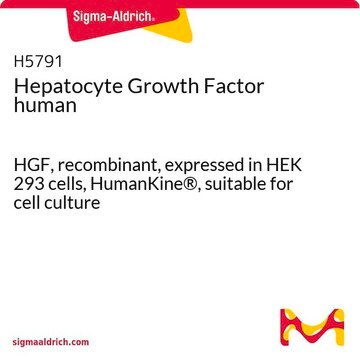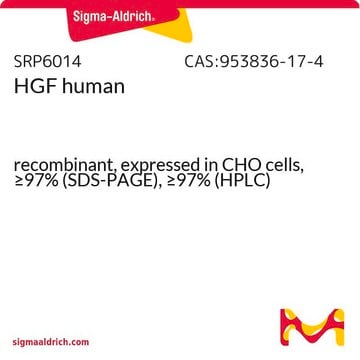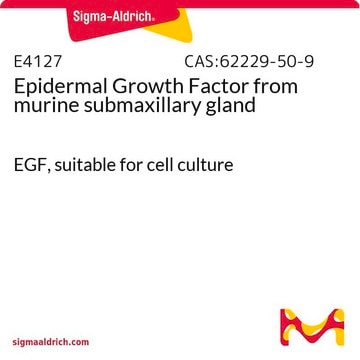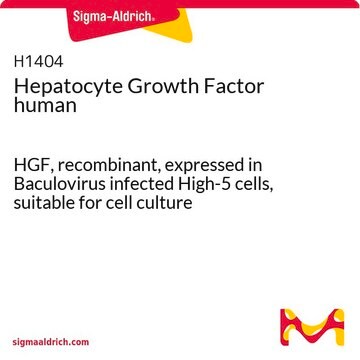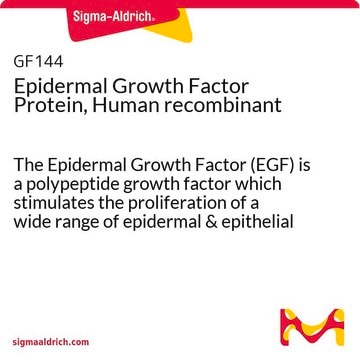GF116
Hepatocyte Growth Factor Protein, Recombinant human
The Human Hepatocyte Growth Factor (or HGF protein) is also known as Scatter Factor & Hepatopoeitin A.
Synonym(s):
HGF
Sign Into View Organizational & Contract Pricing
All Photos(1)
About This Item
UNSPSC Code:
12352202
eCl@ss:
32160405
NACRES:
NA.77
Recommended Products
biological source
human
Quality Level
Assay
>98% (SDS-PAGE and HPLC)
manufacturer/tradename
Chemicon®
technique(s)
cell culture | mammalian: suitable
impurities
<0.1 ng/μg Endotoxin (1EU/μg)
input
sample type mesenchymal stem cell(s)
sample type neural stem cell(s)
NCBI accession no.
UniProt accession no.
shipped in
dry ice
Related Categories
General description
Human Hepatocyte Growth Factor (HGF) is also known as Scatter Factor and Hepatopoeitin A. HGF is a potent mitogen for mature parenchymal hepatocyte cells and acts as a growth factor for a broad spectrum of tissues and cell types. Activities of HGF include induction of cell proliferation, motility, morphogenesis, inhibition of cell growth, and enhancement of neuron survival. HGF is a crucial mitogen for liver regeneration processes, especially after partial hepatectomy and other liver injuries. Human and murine HGF are cross-reactive.
GF116 is an 80 kDa disulfide-linked heterodimeric protein consisting of the alpha chain (463 amino acids) and the beta chain (234 amino acids).
GF116 is an 80 kDa disulfide-linked heterodimeric protein consisting of the alpha chain (463 amino acids) and the beta chain (234 amino acids).
Product Source: Baculovirus infected High-5 cells
Biochem/physiol Actions
The ED(50) was determined by the dose-dependent stimulation of the proliferation of monkey 4MBr-5 cells. The expected ED50 for this effect is 1.0-20.0 ng/ml.
Physical form
The sterile filtered solution was lyophilized from 0.1M L-arginine HCl, 10 mM Tris, pH 8.0, and 200 mM NaCl.
Storage and Stability
The lyophilized protein is stable for a few weeks at room temperature, but best stored at -20°C. Reconstituted HGF should be stored in working aliquots at -20°C. We recommend a quick centrifugation of the vial followed by reconstitution in water to a concentration of 0.5 mg/mL. This solution can then be diluted into other buffers and stored at 4°C for 1 week or stored at -20°C for future use. Avoid repeated freeze/thaw cycles.
Legal Information
CHEMICON is a registered trademark of Merck KGaA, Darmstadt, Germany
Disclaimer
Unless otherwise stated in our catalog or other company documentation accompanying the product(s), our products are intended for research use only and are not to be used for any other purpose, which includes but is not limited to, unauthorized commercial uses, in vitro diagnostic uses, ex vivo or in vivo therapeutic uses or any type of consumption or application to humans or animals.
Storage Class Code
11 - Combustible Solids
WGK
WGK 1
Certificates of Analysis (COA)
Search for Certificates of Analysis (COA) by entering the products Lot/Batch Number. Lot and Batch Numbers can be found on a product’s label following the words ‘Lot’ or ‘Batch’.
Already Own This Product?
Find documentation for the products that you have recently purchased in the Document Library.
Jing Wei et al.
Frontiers in aging neuroscience, 14, 954266-954266 (2022-07-30)
Alzheimer's disease (AD) is a neurodegenerative disorder strongly associates with aging. While amyloid plagues and neurofibrillary tangles are pathological hallmarks of AD, recent evidence suggests synaptic dysfunction and physical loss may be the key mechanisms that determine the clinical syndrome
Lukas Westermann et al.
Scientific reports, 12(1), 18211-18211 (2022-10-29)
Genome editing tools such as CRISPR/Cas9 enable the rapid and precise manipulation of genomes. CRISPR-based genome editing has greatly simplified the study of gene function in cell lines, but its widespread use has also highlighted challenges of reproducibility. Phenotypic variability
Adisak Wongkajornsilp et al.
Methods in molecular biology (Clifton, N.J.), 826, 73-87 (2011-12-15)
Clones of hepatocyte-like cells were reproducibly generated from human mesenchymal stem cells immortalized with a combined transduction of both Bmi-1 and TERT genes. These hepatocyte-like cells contained selective markers and several functional properties of hepatocytes, yet still carried proliferative potential.
Lyugao Qin et al.
The Journal of biological chemistry, 297(4), 101161-101161 (2021-09-05)
Cell migration is an essential physiological process, and aberrant migration of epithelial cells underlies many pathological conditions. However, the molecular mechanisms governing cell migration are not fully understood. We report here that growth factor-induced epithelial cell migration is critically dependent
Our team of scientists has experience in all areas of research including Life Science, Material Science, Chemical Synthesis, Chromatography, Analytical and many others.
Contact Technical Service